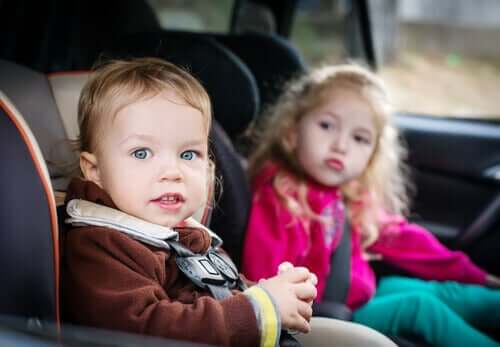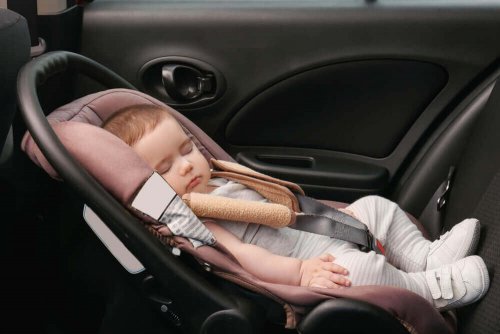How Should a Baby Travel in a Car?

According to statistics, traffic accidents produce a high number of fatalities every year and children occupy an important place within these figures. Hence, it’s crucial for adults to take precautions and to know how a baby should travel in a car.
Education and the correct use of means to transport our children are the best tools for prevention. Join us and find out which are the most efficient safety measures for your child in a car.
How should a baby travel in a car?
In this article, we intend to address two of the aspects related to the way in which babies and young children should travel inside cars. The first is about the safety and prevention of accidents and the second is in regard to the comfort and well-being that we must provide.
Safety and accident prevention
A big mistake that many parents make is to think that driving slowly and respecting the rules exempts them from suffering a mishap. Although we can feel confident in our vehicle, the truth is that, on the road, we don’t only face our criteria as drivers, but also that of hundreds of other people that we will encounter on the road.

Another negative idea that often leads to accidents is the result of the overprotective attitude of parents who want to carry newborn babies or young children in their arms. This action is extremely dangerous, and in percentages, it’s the one that causes more victims with serious or fatal injuries.
The basic rules
The rules for transporting minors in vehicles are very specific and their functionality has been proven multiple times. They indicate that children should always sit in the rear seats of the vehicle using the appropriate child restraint system according to their age. These mandatory systems are classified according to weight and age; parents must adjust them as they grow.
For younger children, who are more vulnerable to fatal impacts inside vehicles, the rule requires that, in addition to transporting them in their child safety seat in the rear, they must be facing the opposite direction of the car’s trajectory. This will help avoid possible injuries due to an impact on the spine, neck, or head.
For all ages, the chairs must be approved and bought in specialized stores. Moreover, you have to deactivate the airbags in front of the children’s heads and they must always use the seat belt without excuses, which you should adjust to their size. Finally, both doors and windows must have the child locks on.

Comfort and well-being
Another essential task for parents is to know how to avoid dizziness in children on trips or during car rides. Motion sickness or disorders in the body due to movements produce small symptoms that are so unpleasant that, in addition to the dizziness, can cause vomiting and general discomfort in the body.
With that in mind, the most effective measures during car rides are the following:
- Children should sit in their special seats and when they get older, they have to put on a seat belt; facing the horizon or, at most, slightly turning their heads towards the window.
- It’s not advisable for kids to eat while riding in the car. We suggest that they only drink water and in few quantities. In case the trip is long, children must eat during the stops.
- You must avoid extreme temperatures inside the car; that is, setting the air conditioner at very low temperatures or too much heat.
- Don’t forget to always place a sunshade next to their window to avoid being exposed to sunlight.
We hope that these tips allow you to be alert and at the same time confident when it comes to driving with your baby on board.
According to statistics, traffic accidents produce a high number of fatalities every year and children occupy an important place within these figures. Hence, it’s crucial for adults to take precautions and to know how a baby should travel in a car.
Education and the correct use of means to transport our children are the best tools for prevention. Join us and find out which are the most efficient safety measures for your child in a car.
How should a baby travel in a car?
In this article, we intend to address two of the aspects related to the way in which babies and young children should travel inside cars. The first is about the safety and prevention of accidents and the second is in regard to the comfort and well-being that we must provide.
Safety and accident prevention
A big mistake that many parents make is to think that driving slowly and respecting the rules exempts them from suffering a mishap. Although we can feel confident in our vehicle, the truth is that, on the road, we don’t only face our criteria as drivers, but also that of hundreds of other people that we will encounter on the road.

Another negative idea that often leads to accidents is the result of the overprotective attitude of parents who want to carry newborn babies or young children in their arms. This action is extremely dangerous, and in percentages, it’s the one that causes more victims with serious or fatal injuries.
The basic rules
The rules for transporting minors in vehicles are very specific and their functionality has been proven multiple times. They indicate that children should always sit in the rear seats of the vehicle using the appropriate child restraint system according to their age. These mandatory systems are classified according to weight and age; parents must adjust them as they grow.
For younger children, who are more vulnerable to fatal impacts inside vehicles, the rule requires that, in addition to transporting them in their child safety seat in the rear, they must be facing the opposite direction of the car’s trajectory. This will help avoid possible injuries due to an impact on the spine, neck, or head.
For all ages, the chairs must be approved and bought in specialized stores. Moreover, you have to deactivate the airbags in front of the children’s heads and they must always use the seat belt without excuses, which you should adjust to their size. Finally, both doors and windows must have the child locks on.

Comfort and well-being
Another essential task for parents is to know how to avoid dizziness in children on trips or during car rides. Motion sickness or disorders in the body due to movements produce small symptoms that are so unpleasant that, in addition to the dizziness, can cause vomiting and general discomfort in the body.
With that in mind, the most effective measures during car rides are the following:
- Children should sit in their special seats and when they get older, they have to put on a seat belt; facing the horizon or, at most, slightly turning their heads towards the window.
- It’s not advisable for kids to eat while riding in the car. We suggest that they only drink water and in few quantities. In case the trip is long, children must eat during the stops.
- You must avoid extreme temperatures inside the car; that is, setting the air conditioner at very low temperatures or too much heat.
- Don’t forget to always place a sunshade next to their window to avoid being exposed to sunlight.
We hope that these tips allow you to be alert and at the same time confident when it comes to driving with your baby on board.
All cited sources were thoroughly reviewed by our team to ensure their quality, reliability, currency, and validity. The bibliography of this article was considered reliable and of academic or scientific accuracy.
- Villalobos P., L., & Hernandez G., R. (2013). Accidentes De Tránsito. Acta Pediatrica Costarricense. https://doi.org/ISSN 1409-0090
- Prado, T., & Muñoz de la Rosa, D. (2009). Politraumatismo. Accidentes de tránsito. Revista Asociación Argentina de Ortopedia y Traumotología.
- Pérez Salas, G., & Bueno Carachi, S. (2012). Seguridad vial y salud pública: Costos de atención y rehabilitación de heridos en Chile, Colombia y Perú. Boletín FAL.
This text is provided for informational purposes only and does not replace consultation with a professional. If in doubt, consult your specialist.








